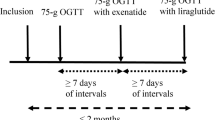Abstract
Objective: To investigate any possible pharmacokinetic interactions that may occur following the coadministration of nateglinide, a new mealtime glucose regulator, and digoxin.
Design and Setting: This was a partially randomised, three-period, nonblind, crossover study performed at a single centre in healthy male and female volunteers aged 19 to 36 years.
Methods: During treatment period 1, all study participants received nateglinide 120mg three times daily for 1 day. They were then randomised to two treatment sequences (n = 6 in each group) in periods 2 and 3, during which they received either a single dose of digoxin 1mg or the combination of nateglinide 120mg three times daily for 2 days plus a single dose of digoxin 1mg on the first day. Blood samples were collected and pharmacokinetic parameters derived. Safety variables measured included ECG parameters and blood pressure.
Results: The concurrent administration of nateglinide and digoxin did not affect the pharmacokinetics of either drug. On the basis of cardiac and haemodynamic assessments, there was no evidence of pharmacodynamic interaction between digoxin and nateglinide. During the study, nateglinide was well tolerated and there were no serious adverse events or drug-related discontinuations in volunteers receiving nateglinide alone or in combination with digoxin.
Conclusion: No adjustment of the dosage of either digoxin or nateglinide is necessary when the drugs are coadministered.




Similar content being viewed by others
References
Aronow WS, Ahn C. Incidence of heart failure in 2,737 older persons with and without diabetes mellitus. Chest 1999; 115(3): 867–8
Reuring RH, Geraets DR. Digoxin. In: Evans WE, Schentag JJ, Jusko WJ, editors. Applied pharmacokinetics. 2nd ed. Washington: Applied Therapeutics, 1986: 570–623
Miura T, Ueno K, Tanaka K, et al. Impairment of absorption of digoxin by acarbose. J Clin Pharmacol 1998; 38(7): 654–7
Ben-Ami H, Krivoy N, Nagachandran P, et al. An interaction between digoxin and acarbose. Diabetes Care 1999; 22(5): 860–1
Serrano JS, Jimenez CM, Serrano MI, et al. A possible interaction of potential clinical interest between digoxin and acarbose. Clin Pharmacol Ther 1996; 60(5): 589–92
Boyd RA, Stern RH, Stewart BH, et al. Atorvastatin coadministration may increase digoxin concentrations by inhibition of intestinal P-glycoprotein—mediated secretion. J Clin Pharmacol 2000; 40(1): 91–8
Verschraagen M, Koks CHW, Schellens JHM, et al. P-glycoprotein system as a determinant of drug interactions: the case of digoxin-verapamil. Pharmacol Res 1999; 40(4): 301–6
Fromm MF, Kim RB, Stein CM, et al. Inhibition of P-glycoprotein—mediated drug transport: a unifying mechanism to explain the interaction between digoxin and quinidine. Circulation 1999; 99(4): 552–7
Shinkai H, Toi K, Kumashiro I, et al. N-Acylphenylalanines and related compounds. A new class of oral hypoglycemic agents. J Med Chem 1988; 31: 2092–7
Karara AH, Dunning BE, McLeod JF. The effect of food on the oral bioavailability and the pharmacodynamic actions of the insulinotropic agent nateglinide in healthy subjects. J Clin Pharmacol 1999; 39: 172–9
Hirschberg Y, Karara AH, Pietri AO, et al. Improved control of mealtime glucose excursion with coadministration of nateglinide and metformin. Diabetes Care 2000; 23: 349–53
Keilson L, Mather S, Walter YH, et al. Synergistic effects of nateglinide and meal administration on insulin secretion in patients with type 2 diabetes mellitus. J Clin Endocrinol Metab 2000; 85: 1081–6
Hu S, Wang S. Effect of antidiabetic agent, nateglinide, on KATP channel in β-cells: comparison to glyburide and repaglinide [abstract]. Diabetologia 1998; 41 Suppl. 1: A139
Cohen A, Kroon R, Seamaker R, et al. The bioavailability of digoxin from three oral formulations measured by specific HPLC assay. Br J Clin Pharmacol 1993; 35: 136–42
Acknowledgements
The authors wish to thank Dr Antoine Tarral of Hôpital Stell in France for his expert medical assistance, as well as Franklin Sun for the statistical analysis. This study is sponsored by Novartis Pharmaceuticals Corporation.
Author information
Authors and Affiliations
Corresponding author
Rights and permissions
About this article
Cite this article
Zhou, H., Walter, Y.H., Smith, H. et al. Nateglinide, a New Mealtime Glucose Regulator. Clin. Drug Investig. 19, 465–471 (2000). https://doi.org/10.2165/00044011-200019060-00009
Published:
Issue Date:
DOI: https://doi.org/10.2165/00044011-200019060-00009




